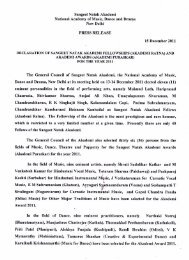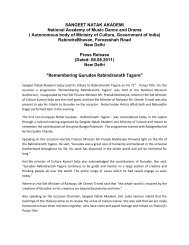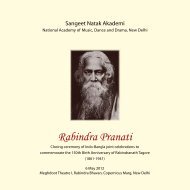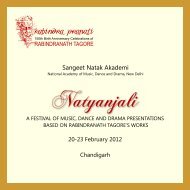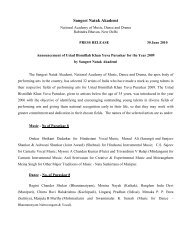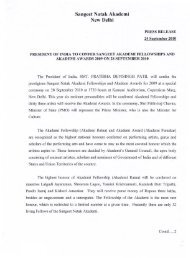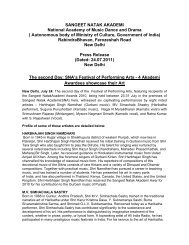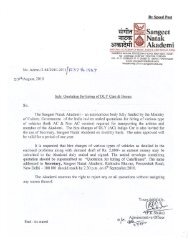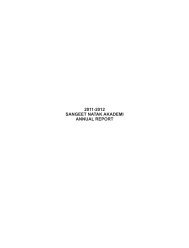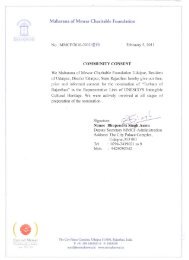National Book Trust, India Sangeet Natak Akademi, New Delhi
National Book Trust, India Sangeet Natak Akademi, New Delhi
National Book Trust, India Sangeet Natak Akademi, New Delhi
You also want an ePaper? Increase the reach of your titles
YUMPU automatically turns print PDFs into web optimized ePapers that Google loves.
<strong>National</strong> <strong>Book</strong> <strong>Trust</strong>, <strong>India</strong><strong>Sangeet</strong> <strong>Natak</strong> <strong>Akademi</strong>, <strong>New</strong> <strong>Delhi</strong>NATIONAL ACADEMY OF MUSIC, DANCE AND DRAMARABINDRA BHAVAN, FEROZE SHAH ROAD, NEW DELHI-110 001Tel: 23387246, 23387247, 23387248, 23382495Fax: 91-11-23382659E-mail: mail@sangeetnatak.gov .inWebsite: http://sangeetnatak.gov .inFestival of Folk and Tribal Performing Arts of <strong>India</strong>4 – 10 February 2013, <strong>New</strong> <strong>Delhi</strong>
Deśaj:An Invitation to the Indigenous Performing Arts of <strong>India</strong>A festival of folk music, dance, and drama, Deśaj complements the <strong>New</strong> <strong>Delhi</strong> World <strong>Book</strong> Fair 2013 focused on ‘IndigenousVoices: Mapping <strong>India</strong>’s Folk and Tribal Literature’. Submerged within the canon of <strong>India</strong>n literature, these voices have graduallymade themselves heard down the years since Independence. Likewise, the performing arts of rural <strong>India</strong> have also asserted theirpresence in the nation’s consciousness, particularly since the latter half of the twentieth century. Political emancipation and theestablishment of a democratic polity have no doubt helped in bringing this vernacular idiom to our attention, and lled in the urbanmindscape with the colours of <strong>India</strong>.However, despite contemporary literary and political debates and a certain privileging of the indigenous voice, it needs to beacknowledged that its presence in urban <strong>India</strong> carries with it a sense of otherness. This is evident in the manner we bring acrossfolk literature in literary forums, and ‘showcase’ the visual and performing arts. Deśaj departs from this norm inasmuch as it seeksto establish, through staged performances and concurrent discussions, the life of <strong>India</strong>’s indigenous music, dance and drama. Wewould hope that the programme succeeds in persuading the lay public to the view that the various performances they witness overthis week do not come off the tourist poster or ‘ethnic’ calendar. They speak of the life experience of disparate communities, oftenunder stress, and therefore subject to change as our own lives are today.Despite the pressures of a globalizing world, the indigenous performing arts of <strong>India</strong> contain within themselves a core ofcontentment which feeds their ebullient expression, a still centre which absorbs and assimilates all tremors from without. They arethe creation of a robust people who have weathered many storms, and are yet ready for battles ahead. They have much joy tooffer even to people across cultures and geographic locations, and a shared sense of our common humanity. It is to suchenjoyment that we invite people gathered at the World <strong>Book</strong> Fair, and hope that the Deśaj experience rounds off their exposure tothe written word of indigenous communities.MONDAY4 FEBRUARYTUESDAY5 FEBRUARYWEDNESDAY6 FEBRUARY4 10 February 2013, 4.30 p.m. dailyLal Chowk Theatre, Pragati Maidan, <strong>New</strong> <strong>Delhi</strong>PANDAVANIChhattisgarhNAADA SAMANWAYAMKeralaMANDRajasthanTHANG-TAManipurLAI HARAOBAManipurBIHU DANCEAssamTRADITIONALBHAJANS, GujaratJHUMAR & NAGPURISONGS, JharkhandRAGINIHaryanaBASTAR BANDChhattisgarhCHOLIYA DANCE &LOK GEET, UttarakhandBHAND PATHERJammu & KashmirKABUI NAGADANCE, Manipur
THURSDAY7 FEBRUARYMonday 4 FebruaryPANDAVANI, ChhattisgarhFRIDAY8 FEBRUARYSATURDAY9 FEBRUARYSUNDAY10 FEBRUARYBAMBOO SYMPHONYKeralaPULIKALI, KeralaKOLKALILakshadweepFOLK DANCE & MUSICOF AO TRIBE, NagalandPURULIA CHHAUWest BengalNAQQALPunjabPARICHAKKALI & ATTAM, Lakshadweep RAS & MAYUR DANCE, Uttar Pradesh BAGRUMBA & BODO DANCE, AssamBOHURA GODHANIBiharGHUMARAOdishaHOJAGIRI DANCETripuraPandavani is a form of narration drawing on the epic Mahabharata, focusing on particularepisodes and elaborating them. The narrator sings the story and then starts a religiousdiscourse addressed to the audience, using mime and dance movements. Two or threemusicians accompany the main performer. These musicians sing the refrain of the songs,comment on the narration, and ask questions in order to emphasize the main parts of thediscourse, heightening the dramatic character of the performance. A Pandavani artist canimprovise on a theme or episode for hours. The musical instruments used by the musicians arethe Tabla and manjira (cymbals). Traditionally, Pandavani was performed only by men. Sincethe 1980s, women have also presented Pandavani.About the artistThe well-known Pandavani artist Teejan Bai began performing Pandavani at a young age. Shecombines speech, song and mime with consummate skill, and has performed widely in <strong>India</strong>and other countries. She has been honoured with the Padma Shri, the Padma Bhushan and the<strong>Sangeet</strong> <strong>Natak</strong> <strong>Akademi</strong> Award.Teejan Bai, lead singer; Kesav Thakur, co-singer; Tirender Kumar, harmonium; Kewal Deshmukh, Tabla;Narottam Netaam, Dholak; Bhagoli Ram, Banjo; Manharan Sarva, Manjira.BOHADA DANCEMaharashtraDHOL CHOLOMManipurBAJASHAL DANCEOdishaSIDDHI DHAMALTRIBAL DANCE, Gujarat
THANG-TA, ManipurThang-ta is the martial art of Manipur practised with sword and spear. In Manipuri, 'thang' is sword and 'ta' means spear. It includes swordght,ght with spears and wrestling (mukna). Originally, these were not clubbed under a performing art but were means of self-defence, oraggression directed against an enemy. Thang-ta provided basic training in warfare, and the kings of Manipur maintained Thang-ta experts intheir courts. At a later stage, this martial art changed into agraceful performing art. Today, Thang-ta is practised both bymen and women. The Dholok and Kartal are used for rhythm.About the groupThe Huyen Lallong Manipur Thang-Ta Cultural Association basedin Irilbung is a premier martial-art institution established in1958 by G. Gourakishor Sharma, a recipient of <strong>Sangeet</strong> <strong>Natak</strong><strong>Akademi</strong> Award and also a <strong>Sangeet</strong> <strong>Natak</strong> <strong>Akademi</strong> Tagore Fellow.The institution has been imparting training in Thang-ta to theyoung people and has performed worldwide in major festivals.Mutum Ibomcha Singh, Wahengbam Dinesh Singh, Thouchom SamumachaMeetei, Naosekpam Rakesh Singh, Md. Sanjit Khan, Yumlembam DineshMeitei, Kangujam Nandikumar Singh, Naosekpam Parbi Devi, SorensabamKamala Devi, Lourengbam Priyadarsini Devi, Hurem Sanatombi Devi,Waikhom Kalpana Chanu, Rosina Yumnam.TRADITIONAL BHAJANS, GujaratGujarati folk music consists of a wide variety of forms such as Garba, Ras, wedding songs,devotional, etc. Bhajans by saints such as Mirabai, Kabir, and Narsingh Mehta are common inthe region. They are sung to the accompaniment of the Ektara.About the artistHemant Rajabhai Chauhan is an accomplished performer of the traditional songs of Gujarat.He has been honoured with the Gaurav Puraskar of the Gujarat <strong>Sangeet</strong> Nrutya <strong>Natak</strong><strong>Akademi</strong>, and is also a recipient of the <strong>Sangeet</strong> <strong>Natak</strong> <strong>Akademi</strong> Award.Hemant Rajabhai Chauhan, lead singer; Bharat Puri Goswami, Tabla; Divyansh Puri Goswami, Tabla;Ashok Bhatti, Manjira; Hamir Vaza, Manjira; Piyush Mokariya, Banjo.
BASTAR BAND, ChhattisgarhThe Bastar Band comprises musical instruments of the Bastar region of Chhattisgarh. These instruments include Muria,Dandami, Madia, Dhurva, Dorla, Munda, Mahra, Gadba, Bhatra, Lohra, Parja, Mirgin, Malba, etc. The musicians are tribesmenof Bastar who regard Lingo Deva as the creator of these instruments.The Group LeaderAnup Ranjan Pandey has been associated with folk theatre of Chhattisgarh for three decades. He began his career as anartist of the Nacha folk theatre. He has researched on folk instruments of Chhattisgarh, and has a rich collection ofinstruments housed in his own museum. The Bastar Band was recreated under his direction. Shri Pandey is currently amember of the General Council of <strong>Sangeet</strong> <strong>Natak</strong> <strong>Akademi</strong>.Anup Ranjan Pandey, Director; Maya Sori, Budhram Sori, Vinod Sori, Koshadeva, Chander Salam, Dasru Korram, Shanti Dugga, Jugo Salam,Shrinath Nag, Kamal Singh Baghail, Samara Ram Nag, Anant Ram Chalki, Vikarm Yadev, Mandai Bhaghail, Rangbatti Bhaghail, BabulalBhaghail, Lacchu Ram Sori, Babulal Sori, Shadur Nag, Phaguram Bhawani, Laxman Poyam, Ludho Sori, Navail Ram Koram, Ashtima Pandey(all musicians).
Tuesday 5 FebruaryNAADA SAMANWAYAN, KeralaNaada Samanwayan is an ensemble of instruments created by the <strong>Delhi</strong> Panchavadya <strong>Trust</strong>. The performance starts with the blowing of theShanku, followed by vocal music accompanied by folk instruments. Temple instruments come last with their stipulated rhythm.About the groupThe <strong>Delhi</strong> Panchavadya <strong>Trust</strong> is a charitable teaching and performing institution engaged in thepromotion of traditional art and culture. Apart from conducting specialized trainingprogrammes, the <strong>Trust</strong> imparts training to young students in percussion andother instruments. Based in the Capital, it works with the objective ofreviving interest in the traditional art and culture of Kerala. The <strong>Trust</strong>also provides nancial assistance and support to old and ailingartists.Cheruthazam Kunhiraman Marar, Chenda; Kalabharthi Jayakumar,Chenda; PV Manoj, Maddalam; Vijesh, Maddalam; JanarthananPudessheri, Udukku; Venkat, Udukku; Nandkumar, Eddakka; MadhuMarar, Kombu; Govindan, Kombu; Sasi Nambisan, Thalam; Vijesh,Thalam; Kalyana Krishnan, Shanku; Sunil Kumar, Shanku;Janarthanan Pudusseri, Folk Music; Jayaprakash, MayuraNirtham.LAI HARAOBA, ManipurThe Lai Haraoba is a ritual enactment of the legend of the creation of the world, performed before village shrines with singing, chanting anddancing. It incorporates the popular love epic of Khamba-Thoibi. While dancing to invoke the deity, one of the Maibi priestesses falls into atrance and becomes possessed. The end comes with the Thougal Jagoi offering to the deity made by other participants for peace andprosperity to the people of the land.About the groupThe Huyen Lallong Manipur Thang-Ta Cultural Association based in Irilbung is a premier martial-art institution established in 1958 by G.Gourakishor Sharma, a recipient of <strong>Sangeet</strong> <strong>Natak</strong> <strong>Akademi</strong> Award and also a <strong>Sangeet</strong> <strong>Natak</strong> <strong>Akademi</strong> Tagore Fellow. The institution has beenimparting training in Thang-ta to the young people and has performed worldwide in major festivals.Mutum Ibomcha Singh, Wahengbam Dinesh Singh, Thouchom Samumacha Meetei, Naosekpam Rakesh Singh, Md. Sanjit Khan, Yumlembam Dinesh Meitei,Kangujam Nandikumar Singh, Naosekpam Parbi Devi, Sorensabam Kamala Devi, Lourengbam Priyadarsini Devi, Hurem Sanatombi Devi, Waikhom Kalpana Chanu,Rosina Yumnam.
JHUMAR and NAGPURI SONGS, JharkhandJhumar is a post-harvest dance performed by the men of the tribes of Jharkhand. Themovements and the accompanying music are martial in character, and the dancerscarry swords in their hands. Occasionally, two or more female dancers join in thedance with the men. It is accompanied by the Shehnai, Dhol, Karah, Nagara, Jhanjhand Kartal. A different Jhumar dance is performed by women in the rainy seasonduring the period of cultivation. Men participate in this dance as drummers, dancers,and singers. Nagpuri songs are sung by all the tribes of Jharkhand on every festiveoccasion.The Group LeaderMukund Nayak is a well-known poet, composer, musician, singer, dancer and scholar.He has directed theatrical productions and also worked as music director for NSD'stheatre productions such as Kalidas, Shakuntala, etc. Shri Nayak has been honouredwith the Centre for Education Award and also the Jharkhand Ratan Award by theGovernment of Jharkhand. He established Kunjban, a Chhotanagpuri folk music anddance training centre in 1985, out of which has grown a number of performingtroupes which have travelled all over the world participating in notable festivals.Mukund Nayak, lead singer; Dharmu Nayak, Kishore Nayak, Ganesh Mahli, Kishore Mahli, BholaNayak, Deepak Nayak, Sagar Munda, Suraj Mahli, Sumit Oraon, Chandrakanta Kumari, BineetaKumari, Saroj Lakra, Magdali Lakra, Isha Munda (other singers and musicians).CHOLIYA DANCE and LOK GEET, UttarakhandCholiya dance originated in the Kumaon region of Uttarakhand. Also known as the sword dance, it is relatedto the martial traditions of the Kumaoni people. More than a thousand years old, this art form is mainlyperformed by the Rajput community in their marriage processions. In the performance they use Turi, Ransingand Mashakbeen, the typical Kumaoni instruments. Perfectly synchronized, and marked with jumps and turnsof the body, the dancers show several sword- ghting feats. Attired in the martial costumes of ancientwarriors, the ashing swords and shields of the dancers, along with the war-like music, huge red ag withvarious animal symbols stuck on it conveys fear, joy, awe and wonder, through eyes, eyebrows andshoulders, creating an impression of a group advancing for an attack. Nowadays, people of any caste inKumaon hire the choliya dancers to make their ceremonies more beautiful and vivacious.The Group LeaderGopal Mathpal has sung more than 500 folk songs of Uttarakhand and worked with reputed nationalcompanies such as T-Series, and has many audio-cassettes to his credit. He has also directed and composeda number of traditional songs, and has participated in many festivals in <strong>India</strong> and abroad.Gopal Mathpal, lead singer; Deepa Panth, lead singer; Kishore, chorus; Prakash, chorus; Mridala Rawat, Chorus; Lalit,dancer-Sarnkar; Prakash, dancer-Sarnkar; Prakash Dholakhandi, Rohati; Chandan Shotyal, Nagada; Harish Kumar,Mashakbeen), Bhagat Singh, Ranasinga; Jaypal Negi, dancer; Kamla, dancer; Krish, dancer; Bhawana Brathwal, dancer;Kishan Kumar, dancer; Nidhi, dancer; Shivdatt Pandey, harmonium; Gaurav, Dholak; Shatendu Negi, ute; Mahesh Panth,Hudka.
KABUI NAGA DANCE, ManipurThe Kabuis are one of the Naga tribes living on the western mountains of Manipur. Over time they have developed a strong taste for danceand music. The dance of the Kabui Nagas is accompanied by rhythmic drum beats which holds the interest of the audiences. It is alsoregarded as the dance of the gods and thus has to be performed with perfect submission and devotion to the deity concerned. There aredifferent kinds of Kabui Naga dances performed on different occasions. For example, Gaan Ngai Laam (Laam means dance), Tamchan Laam,Gaanpi Kadimei Laam, Khangbon Kadimei Laam, Karapei Kadimei Laam, Tun Ngai Laam, etc., are performed at different times of the year.About the groupKabui Naga Dance is being performed by the artists of The Huyen LallongManipur Thang-Ta Cultural Association. The Huyen Lallong Manipur Thang-Ta Cultural Association based in Irilbung is a premier martial-artinstitution established in 1958 by G. Gourakishor Sharma, a recipient of<strong>Sangeet</strong> <strong>Natak</strong> <strong>Akademi</strong> Award and also a <strong>Sangeet</strong> <strong>Natak</strong> <strong>Akademi</strong> TagoreFellow. The institution has been imparting training in Thang-ta to theyoung people and has performed worldwide in major festivals.Mutum Ibomcha Singh, Wahengbam Dinesh Singh, Thouchom Samumacha Meetei,Naosekpam Rakesh Singh, Md. Sanjit Khan, Yumlembam Dinesh Meitei, KangujamNandikumar Singh, Naosekpam Parbi Devi, Sorensabam Kamala Devi, LourengbamPriyadarsini Devi, Hurem Sanatombi Devi, Waikhom Kalpana Chanu, RosinaYumnam.Wednesday 6 FebruaryMAND, RajasthanMand is a famous style of singing of Rajasthan. It is well recognized in classical circles, but is neither accepted as afull- edged Raga nor is it reckoned among the freely rendered folk songs. It is very near the Thumri or the Ghazal. Thefamous Rajasthani song Kesariya Balam is in the Mand style.About the artistA noted performer of Kartaal and Dholak, Shri Khete Khan Manganiar has also trained in Rajasthani, Gujarati, Sindhi,and Punjabi regional music and has performed widely in the country as well as abroad in France, Germany, Japan, UK,USA and South Africa. He has also accompanied Shri Zakir Hussain on Tabla with Kartaal in prestigious festivals in theUSA.Khete Khan Manganiar, Kartaal; Kachra Khan, vocal; Deena Khan, vocal; Dara Khan, Kamaicha; Aasin Khan, Sindhi Sarangi; Sheru Khan,Algoja; Goram Khan, Dholak.
BIHU DANCE, AssamThe Bihu dance is associated with the spring festival of that name, widely celebrated in Assam. Young men and women perform the dancewith brisk steps, rapid hand movements, and a rhythmic swaying of the hips to the accompaniment of the dhol (drum), taal (cymbals), moharsingar pepa (a pipe made from buffalo horn), gagana (a wind instrument made from reed and bamboo), and taka (bamboo clapper). The Bihusongs tell of youthful love and the pangs of separation. Celebrated before and after the harvest, Bihu has fertility as its central theme.The Group LeaderMadhusmita Handique graduated in Kathak dance from Prayag <strong>Sangeet</strong> Samiti, Allahabad, and obtained her Masters degree in Kathak fromIndira Kala <strong>Sangeet</strong> Viswavidyalaya. Madhusmita has also completed Diploma Honours from Kathak Kendra, <strong>New</strong> <strong>Delhi</strong>. She has also learnt thefolk and traditional dances of Assam and has given performances in many festivals in the country.Madhusmita Handique, group leader; Jasmin, Anjali, Pariksha, Tejaswini, Shivani, Harshita, Irani Sonowal, Pallavi, Naresh, Utpal, Avinash, Himanshu, Mukut,Mukesh, Lakshya, Rajender, Jeetu Gogoi, Rituraj Sonowal, Lohit Gogoi (other dancers and musicians).
RAGINI, HaryanaHaryana has played an important role in the folk song tradition of northern <strong>India</strong>. The folk songs of Haryanaare of two types muktak and kathaatmak. The rst type represents ritual, seasonal, harvesting, children,and festival songs in general. The second type comprises historical, as well as imaginative and creativesongs on great personalities. Raginis are songs of the second type sung in the folk theatre of Haryana andits neighbourhood which are known as Swangs and are akin to Nautanki in theme, structure, and technique.The Group LeaderPrem Singh Dehati has been a traditional performer of Haryanvi folk songs including the Ragini style ofsinging. An A-grade artist of Aakashwani, Shri Dehati has presented his programmes in the AakashwaniKendra of <strong>New</strong> <strong>Delhi</strong>, Rohtak, Hissar and Kurukshetra. He has acted in a number of musical plays and Swangperformances. He has performed all over the country and has also travelled to many countries forperformance, such as Nepal, Libya, Syria, Ghana, Burkina Faso, Morocco, Tunisia and Egypt.Prem Singh Dehati, lead singer; Umed Singh, co-singer; Ratan Lal, co-singer; Rajesh Kumar, Sarangi; Ram Mehar,harmonium; Pale Ram, Dholak; Azad Singh, Nagara; Om Parkash, Kilat.BHAND PATHER,Jammu and KashmirThe word Bhand is derived fromSanskrit 'Bhanda', which means to jest,to mimic. Therefore one who acts as amimic or is a strolling actor, plays uponthe Svaranav or Shahnai, works as abuffoon or gives a dramatic performanceis called a Bhand. A Bhand Pather isthat dramatic performance which is puton by the Bhands. At folk festivals ofJammu and Kashmir, the Bhandsperform one play or the other and it isthese plays that are called BhandPather. Whichever character-type aBhand may imitate, that character'sname suf xed to the term Patherbecomes the title of the folk-play inwhich his conduct is imitated.
The play is based on a Kashmiri folktale of a Gosain (Sadhu) and a milkmaid, Gopali, who is attracted by the Gosain. As a result, the milkmaid starts participating in the religious discourses given by the Gosain. Unaware of her infatuation for him, the Gosain increases hisassociation with her, taking her keen interest to be a desire for spiritual enlightenment. This increased association encourages her, andone day she expresses her love for him and says that she is ready to sacri ce everything, renounce worldly comforts, and tread upon thedif cult path of the ascetics. But the Gosain, who has started the relationship with much con dence in his asceticism, nds himselfunable to face her beauty at this point, and he vanishes. The play does not end here, for the dilemma now is how to perform the Gosian'slast rites in the absence of his body. A situation open to satire is taken up by the three Vidushakas with much aplomb. Kashmiri is themain language of the play, however Hindi and Sanskrit languages are also used.The Group Leader Shah-e-Jahan Ahmad Bhagat is a young talented artist of Bhand Pather, and he has been honoured with the UstadBismillah Khan Yuva Puraskar of <strong>Sangeet</strong> <strong>Natak</strong> <strong>Akademi</strong>. He has participated in many prestigious festivals in the country includingfestivals organized by the <strong>Sangeet</strong> <strong>Natak</strong> <strong>Akademi</strong>.Shah-e-Jahan Ahmad, group leader; Gh. Mohi-U-Din Aajiz, Gh. Qudir Bhat, Ab. Hamid Bhat, Gh. Ahmad Bhat, Nazir Ahmad Bhat (I), Nazir Ahmad Bhat(II), Fayaz Ahmad Bhat, Riyaz Ahmad Bhat, Manzoor-ul-Haq, M.Hashim Bhat, Mehraj Ahmad Bhat, Johan Mohd Bhat, Abid Hussain Baghat, Farooq AhmadBhat
Thursday 7 FebruaryBAMBOO SYMPHONY, KeralaThe bamboo symphony is a contemporary musical endeavour originating in efforts made for the conservation of bamboo and grasses of theWestern Ghats. The idea was to listen to the forest and create a living orchestra. Not the clang of electronic instruments but pure sound as itwould come through the bamboo reed. The team comprising the symphony made their own instruments and sourced ideas for the music fromindigenous instruments.About the groupGrowing up close to the Athirapally Falls, Unnikrishna Pakkanar relished the songs of the forest close by. Hearing the Malabar hornbill and itsmany calls, he went on to produce its voice on an instrument that the group made themselves and called Amba. The unique spell cast on himinfected many others like Ullash Kumar and became the genesis of the Bamboo Symphony. The group calls itself Mula Padum Ravu (TheBamboo That Sings Through the Night).Unnikrishna Pakkanar, lead musician; Ullash Kumar, Bishoy, Balamurali, Anilkumar, Philipose, Skandhan, Ramu, Kumar, Sandheep.
FOLK DANCE and MUSIC OF AOTRIBE, NagalandThe Ao Naga tribe is found in the northeasternpart of Nagaland, mostly in theMokokchung district of Nagaland, and also afew in the State of Assam. The Ao Nagashave a rich tradition of clothing, whichbesides ful lling the decorative needs of thepeople, also serves to visually distinguishthe warriors from the commoner class. TheAo Naga warrior shawl is calledMangkotepsu. This is exclusively worn by themenfolk.The Aos observe a week-long festival calledMoatsü Mong after the sowing is done andthe mother earth begins to show signs offertility. The festival provide the Aos aperiod of recreation after the strenuous jobsof clearing the elds, burning jungles andsowing seeds, cleaning up the tsübu (wells), and repairing and constructing houses. The festival is marked by vigorous songs and dances,merry-making and fun. The womenfolk join the menfolk in dancing, eating and drinking and composing warrior songs. Songs were sung inpraise of the lovers and the village as a whole, and the older menfolk would encourage the young people to be bold and heroic in order todefend and protect them from enemies.Another festival called Tsüngrem Mong is celebrated on the eve of the harvest. However, nowadays the Aos celebrate this festival in themonth of August. Parties of old and young wearing their colourful costumes sing songs and perform dances to express their gratitude to theSupreme Power for helping the crops to grow well. They provide the best of offerings to the Supreme Power for its abundant blessings. Thesefestivals provide opportunities to the upcoming generation as well as the village stalwart to demonstrate their intellectual skill and physicalpowers. A handful of young men hold the stage and tell amusing stories about their elders. Peals of laughter greet them and the young andthe old alike jump in excitement. These festivals are usually rounded off by a tug of war between the men and the women, which generallythe men lose charmed by the grace of the womenfolk!The Group LeaderSatemmeren Longkumer is a well-known folk singer of Nagaland. He is unique among traditional artists of the region in having devotedhimself simultaneously to literary work on folk music, folk literarure, and social practices among the Naga tribes. He has been honouredwith the <strong>Sangeet</strong> <strong>Natak</strong> <strong>Akademi</strong> Tagore Award.Satemmeren Longkumer, group leader; Alempokba Jamir, Atula, Ladongpokla, Chungpongnungsang, Soyim Imsong, Imlimatsung, Mepukumzuk, Toshiwapang,Imlikala
PURULIA CHHAU, West BengalPurulia Chhau is a dance performed with masks in Purulia as a ritualistic offering to the SunGod during the month of Chaitra. The themes of Purulia Chhau are derived from the epics andmythological texts. Colourful masks and headgears, expressive exions combined withvigorous drum beats are characteristic features of this form. The dance imagery andterminology are deeply rooted in the local dialect and practices. The masks are made of papiermache and the headgears decorated with zari and indigenous materials.About the artist / groupAdibashi Chhau Dance Party was established in Purulia district of West Bengal by late GambhirSingh Mura, Padma Shri and <strong>Sangeet</strong> <strong>Natak</strong> <strong>Akademi</strong> Awardee. The group has since travelled tomany cities of Europe, Asia and USA for performance of Purulia Chhau. Kartik Singh Mura isworking as organizer of this group.Kartik Singh Mura, group leader; Parsuram Singh Mura, Bhagumewser Singh Mura, Banshi Mahato,Bhagirath Paramamik, Budhu Mahato, Gopal Mura, Radha Mura, Krishna Karandi, Gurupada Machugar, KalaMura, Lakshman Mura, Washi Karmakshi, Shanti Mahato.NAQQAL, PunjabNaqqal is a folk theatre form of Punjab performedtraditionally by men. The contents are satirical,relating largely to contemporary themes, withsharp comments on social and political events butsometimes also including episodes from the lovelore of Sassi-Punnu, Heer-Ranjha etc. The formatis essentially musical, with improvised dialogue,songs and dance movements used as devices toheighten the dramatic effect. Accompaniment isprovided on the Dholki, Ghara Tabla and Sarangi.The Group LeaderMehar Chand is a well-known folk singer of Punjab, and has widely performed all over the country and abroad. He has also worked withNeelam Mansingh s Theatre Group. He is well versed with playing the harmonium as also folk instruments. His grainy hoarse voice suggests acracked surface of notes that roams freely, assuming new rhythms and individual cadence. He has established his own group Mehar ChandMastana Musical Group and is performing regularly.Mehar Chand, group leader; Bahadar Chand, Amarjeet Singh, Gurmeet Kurar, Mundari Lal, Dessraj, Ram Singh, Satnam Singh, Surjeet Singh, Sohan Lal, Charne,Lucky, Jassi, Sukhi, Nicka.
Friday 8 FebruaryPULIKALI, KeralaPulikali is literally tiger play , Puli meaning tiger and Kali play in Malayalam. The performance revolves around the theme of tiger hunting.It is a colourful recreational folk performance presented by trained artists to entertain people on the occasion of Onam, the annual harvestfestival. On the fourth day of the Onam celebrations (Nalaam Onam), performers painted like tigers and hunters in bright yellow, red, andblack dance to the beat of drums such as Udukku and Thavil. Pulikali is mainly practised in Thrissur district of Kerala and its performanceattracts thousands of people to Thrissur city.Pulikali dates back to some two hundred years, when Maharaja Rama Varma Sakthan Thampuran, the then Maharaja of Cochin, introduced thefolk art, wanting to celebrate Onam with a dance that exhibited a wild gusto. Later, Muslim soldiers of the British Army stationed inThrissur's army cantonment used to perform Pulikali with great fervour. They popularized the folk genre with steps and body language properto a tiger being stalked by a hunter, enacting the play of the hunter and the beast. This performance was immensely enjoyed by the localpopulation. In the early days, masks were not used at all and participants would have themselves painted all over - on their faces as well.But now, readymade masks, cosmetic teeth, tongues, beards and moustaches are used by the players together with body-painting. The 'tigers'also wear a broad belt with jingles around the waist.About the group Thrissur Pulikali Sangam has been performing for the last ten years. Artists of the Sangam have performed in several citiesin <strong>India</strong> including Kolkata, Pune, Chennai and Bangalore.K.A. Balakrishnan, group leader; C.S. Rajesh, player; V.S. Shyamasankar, player; A.V. Vijith, drummer, V.S. Mohandas, player; K.G. Nandanan, player; K.G.Shanmughan, player; V.M. Suresh, artist; V.R. Rajesh, drummer; V.M. Subhash, drummer; A.S. Subhash, player; T.K. Madhavan, player; T.G. Rajesh, player; M.N.Ravindran, drummer.
PARICHAKKALI and ATTAM, LakshadweepThe Parichakkali dance is a very popular dance form inthe islands of Lakshadweep. Parichakkali literallytranslates as Shield Dance. As Paricha refers to a shieldand as the dance is performed with sword and shields,it is called Parichakali. This dance form somewhatresembles a martial art form with swords and shieldsused as props. They are, however, made of very softwood so that while enacting the dance nobody iswounded. Wars and warriors and the freedom struggleare the common themes. The performance isaccompanied by songs. What begins as a slow danceincreases in tempo to culminate in a highly energeticdance.Attam means dance. It is a performance based onsongs written about the social life of the local peopleand is performed both by male and female troupes as afree style dance without using any instruments. Thedancers move forwards and backward, to the right andleft, showing symbolic gestures with their hands andlegs.About the groupRajiv Memorial Arts and Sports Recreation Club wasestablished at Kadmat, Lakshadweep and has beenworking for more than 15 years with all the folk formsof Lakshadweep. K.C. Saheed Ali is imparting trainingto many young artists under the Guru ShishyaParampara. This group has traveled to Kashi, Srinagar,Madras, etc., for performance so far. It is also thechampion team of four art forms in LakshdweepDollipattu, Parichikkali, Kolkali and Attam.Shukoor U.C., Mohammed T.A., Abdul Hamid B.C.,Hidayathulla B.C., Mohidheen K.C., Hidayathulla B.K.,Bunjamin P.K., Ashraf K.K., Kunhi P.A., Cheriyakoya U.C.,Sha P.P., Mohammad Ali K., Muthukoya P.M.P., Sameer B.C.
RAAS and MAYUR DANCE, Uttar PradeshRaas Leela tells about Krishna's childhood. According to the Bhagavad Purana, Krishna and the Gopis had danced the Raas on the banks ofthe Yamuna at Vrindavan. When the gopis felt conceited about Lord Krishna dancing with them, he disappeared from their midst. In theagony of separation from their beloved Krishna, the gopis enacted his leelas (divine episodes of his life) which in course of time came to beknown as the Raas Leela. The charming childhood pranks of Shri Krishna constitute the main theme of these dramas.The Mayur or peacock dance is created from an episode in the love lore of Radha and Krishna: Radha, pining for Krishna after a briefseparation, decides to console herself by the sight of peacocks, whose feathers Krishna wears on his crown, at the Mor Kuti pavilion. Krishna,knowing her mind from afar, playfully causes the peacocks to disappear, leaving Radha distraught. He eventually yields to Radha's entreatiesand himself appears in the guise of a peacock to dance with his beloved.This dance belongs to the Braj region of Uttar Pradesh with its core at Mathura and Vrindavan, places associated with Lord Krishna.About the groupCharkula Arts Academy was established in 1982 to promote the dance, music and culture of Uttar Pradesh, and to impart this training tostudents. The organization produces original dance works and sponsors festivals, exhibitions and workshops; supports research into raredance forms and gives professional opportunities to budding artists. The aim of the Academy is to keep the traditional arts of artistcommunities alive by providing them services to meet the basic needs they have identi ed. The academy has performed traditional Charkulaand other <strong>India</strong>n Folk and Classical Dances at several prestigious venues in <strong>India</strong> and abroad such as Village Festival-2000 in Singapore andat the Dubai Shopping Festival.Murari Lal Sharma, Sanjay Kumar Sharma, Atalbihari Mishra, Rasbihari Mishra, Satish Kumar, Tara Chand Premi, Lek raj Sharma, Subhash Sharma, Rameswar,Pehlad Singh, Awdesh Mishra, Poojasaini, Arti, Sonia Sharma, Shalu Sharma.
BAGRUM-BA DANCE OF THE BODOS, AssamBagrum-ba is the dance of the Bodo community of Assam. The life of the Bodos is uniquelyre ected through it. It is performed exclusively by girls, dressed in colourful attire, to theaccompaniment of musical instruments such as siphung ( ute) and kham (drum). Holding theends of colourful scarves hung round their necks, the dancers move forward and backward withalternate footsteps to the accompaniment of the kham and siphung. The dance, which takes acircular pattern, is characterized by jerks of the waist, and a graceful forward and backwardswinging of the body.About the groupBodoland Cultural Centre was established in 1994 in Assam with the aim to preserve andpromote Bodo culture. The centre is conducting training programme to impart Bodo culture tothe younger generation of their community. This centre has participated in the Lok TarangFestival of Folk and Traditional Performing Arts held during the Republic Day Celebration of theGovernment of <strong>India</strong>. It has also participated in the Octave Series held at Hyderabad,Thiruvananthapuram, Goa, Aurangabad, Bangalore, Nagpur, etc., and has also travelled toBhutan for performance.Barlangfa Narzary, group leader; Sudem Basumatary, Rwmwilu Brahma, Manjit Brahma, Uraidao Brahma,Bijinta Basumatary, Upa Bala Muchahary, Sanjila Brahma, Anima Brahma, Sanima Narzary, Bibari Basumatary,Tanuja Narzary, Ranjita Brahma, Momi Basumatary, Priya Basumatary.
Saturday 9 FebruaryKOLKALI, LakshadweepThe Kolkali dance literally translates as stick dance. The word 'Kol' refers to a stick, and because the dance is performed with sticks, it iscalled Kolkali. Kolkaki dance is the most widely known and popular folk dance of Lakshadweep. The performers comprise only of men. Womenare not allowed to perform and practice this dance form. Kolkali is danced in pairs and the pairs move in circles to the rhythmic beat ofsticks. The performers hold these special sticks in their hands and use them as props while dancing. The dance begins at a slow pace, butslowly as the time passes the tempo becomes fast and ultimately reaches to the height of frenzy. The dancers dance in a variety of alignmentin due course with the accompanying folk songs.About the groupRajiv Memorial Arts and Sports Recreation Club was established at Kadmat, Lakshadweep and has been working for more than 15 years withall the folk forms of Lakshadweep. K.C. Saheed Ali is imparting training to many young artists under the Guru Shishya Parampara. This grouphas traveled to Kashi, Srinagar, Madras, etc., for performance so far. It is also the champion team of four art forms in LakshdweepDollipattu, Parichikkali, Kolkali and Attam.Shukoor U.C., Mohammed T.A., Abdul Hamid B.C., Hidayathulla B.C., Mohidheen K.C., Hidayathulla B.K., Bunjamin P.K., Ashraf K.K., Kunhi P.A., CheriyakoyaU.C., Sha P.P., Mohammad Ali K., Muthukoya P.M.P., Sameer B.C.
BOHURA GODHANI, BiharBohura Godhani is a popular folk play of Bihar. It is popular among the dalits and the poor people of the State. The story of the playrevolves around the struggle of a poor woman Bohura Godhani for the right of the poor people over the river Kamla. Bhimal Sahani ofBharora State obstructs the course of the river Kamla and deprives the people of Bakhari Bazar of their right to sh in the Kamla river.Indeed, the very livelihood of the people of Bakhari Bazar is in danger. This folk play is a testimony of women empowerment and thestruggle of the common people for their right over natural resources.About the groupAnupam Seva Samiti is a group of folk artists. They perform the play on occasion of rural festivals and marriage ceremonies. The activity ofthe group is monitored at its centre in the district of Begusarai, Bihar and this group has performed many plays at almost every place in theState. The group has presented this play in the festival organized by the Department of Art and Culture, Government of Bihar and in the folkfestival organized by EZCC.Hasan Imam, group leader; Brahamdeo Paswan, Ranjeet Ram, Pawan Kr Paswan, Saroj Kr Paswan, Rambali Paswan, Mangal Das, Lalbaboo Sahani, NandelalRam, Ram Kr Ram, Jagdish Das, Mahesh Sahani, Satya Narayan Ram, Moti Paswan, Paramjeet Kumar.
GHUMURA, OdishaGhumura is a popular traditional dance of Kalahandi in Odisha so named after an instrument named Ghumurawhich produces a Ghum Ghum sound. The Ghumura dance has become an indispensible part of manyauspicious ceremonies in that part of Odisha. The music of this dance causes a thrill to pass through theaudience. The dance is accompanied with many traditional instruments like Ghumura, Nisan, Jhanj, Turi orTala, Madal and Bheri. About fteen to twenty artists of different caste, creed, religion, colour, etc. performthis dance nowadays. Ghumura has already earned a name for itself not only in Odisha but all over <strong>India</strong>.About the group'Prativa' started working with the college students and the youths of Sadar Block, Bhawanipatna in the year2000. Today its activities are carried out throughout all the blocks of Kalahandi district of Odisha. The focusof the group is on mobilizing the youth for various programmes and providing a platform to show theirtalent to the society. The objectives addressed through the programmes includes building the capacity of theyouth and establishing an effective partnership between the student associations and Prativa to raise issuesand focus on the problems of folk culture in general and the youth in particular. Work at the district andstate levels throw up issues that have a direct bearing on governmental policies, practices and procedures.In the process, attempts are being made to create an enabling environment for reconstructing the tribalculture.Dhayanananda Panda, group leader; Chintu Prashad Naik, Anil Ku. Rout, Rajesh Ku. Singh, L. Iswar Rao, GourisankarDurga, Tarun Kumar Durga, Narayan Podh, Janmejaya Naik, Sarbeswar Bhoi, Chinmaya Naik, Nabanita Hota, SnigdhaSahani, <strong>Sangeet</strong>a Rout, Jyoti Rani Mohanty.HOJAGIRI DANCE, TripuraThis is a dance of the Reang community of Tripura. It ismainly a women's dance interspersed with acrobatics.The dancers are accompanied on a drum called kham,chempreng a stringed instrument and the ute. Themovements of the hands and the upper part of the bodyare restricted, but the movements from the waist downto the feet create a wonderful wave. Standing on anearthen pitcher with a bottle on the head along with alighted lamp placed over it, the Reang women dancetwisting the lower part of the body rhythmically.About the artistShri Udayram Reang is a popular folk singer of the Reangcommunity of Tripura. He has performed for festivalsorganized by zonal cultural centres and has givenperformance in many cities of the country.Udayram Reang, Pradip Kr Reang, Khailaram Reang,Jongbahadur Reang, Netajoy Reang, Abhindra Reang, BalindraReang, Renuka Reang, Urati Reang, Napanti Reang, JinabatiReang, Ramila Reang.
Sunday 10 FebruaryBOHADA DANCE, MaharashtraBohada is a play-dance folk form of Maharashtra which is popularly known as the maskdance. It is performed throughout the night by villagers as a sort of fertility ceremony. LordGanesh, Riddhi, Siddhi, Saraswati, Ravan, etc., are the some characters presented in Bohadawith the help of masks. Bohada play-dance is performed with Sambal and Sanaiinstruments. Bohada is performed by the tribal people in Thane, Nasik district and also bythe villages in North Maharashtra.About the artistShri Rajan Laxman Vaidya is a practitioner of folk culture and traditional dance. He has givenperformances in the festivals organized by the Department of Tourism, Maharashtra;Surajkund Craft Mela, Haryana; Republic Day in <strong>Delhi</strong>; Bal Sangam by <strong>National</strong> School ofDrama; Folk festival by Government of Maharashtra, and has travelled to many States forperformances.Rajan Vaidya, group leader; Nikhil Lodhande, Lalit Kadam, Jatin Vaidya, Dipak Tandel, Nakul G. Thakere,Naresh Padekar, Shankar Mali, Ramesh Dakhane, Shida Mali, Barkya Bhore, Kakdya Bhore, BhagiratJadhav, Dhrma N Dangte, Lahu Dhondga.DHOL CHOLOM, ManipurHoli, the colourful spring festival of <strong>India</strong>, is known in Manipur as Yaoshang. Duringthis festival, people indulge in dance and music with gay abandon. Dhol Cholom, adrum dance, is an essential part of these festivities in which men dance to theaccompaniment of a variety of percussion instruments played by themselves andcharacterized by the modulation of sound from soft whisper to a thunderous climax. Itis performed at various temples like Shree Govindaji temple. Among the variouspercussion instruments used are the Dhol, Dholok, Dafat and Kartal.About the artistShrimati Dhanarani had completed her Post Diploma Course in Manipuri Ras in 1978from Jawaharlal Nehru Manipur Dance Academy Imphal and has worked in the repertoryof this Academy as an artist. Later she joined the Triveni Kala Sangam in <strong>Delhi</strong> in theyear 1980 as an artist under the directorship of Guru Singhajit Singh, and has workedfor sixteen years travelling to many parts of the country and abroad for performances.In the year 2001 Shrimati Dhanarani established the Pathoibi Jagoi Marup in <strong>Delhi</strong>,which has participated in a number of festivals both in <strong>India</strong> and abroad like the DubaiShopping Festival, etc.Basu Singh, Pradip Singh, Surmani Singh, Thoithoi Singh, Joybi Singh.
BAJASHAL DANCE, OdishaGhumura, Dhap, Ghudka Changu, Banabadi are the most prevalent Bajasalia dances of Odisha. Bajasal is the most ritual-based dance of thetribal people of Odisha. Both male and female perform to observe particular rituals. Bajasal arises in their heart, and lled with greatpleasure the exuberant youth start to dance by listening. The body gradually becomes straight or becomes bajasalia in the local language.Prativa started working with the college students and the youths of Sadar Block, Bhawanipatna in the year 2000. Today its activities arecarried out throughout all the blocks of Kalahandi district of Odisha. The focus of the group is on mobilizing the youth for variousprogrammes and providing a platform to show their talent to the society. The objectives addressed through the programmes includes buildingthe capacity of the youth and establishing an effective partnership between the student associations and Prativa to raise issues and focus onthe problems of folk culture in general and the youth in particular. Work at the district and state levels throw up issues that have a directbearing on governmental policies, practices and procedures. In the process, attempts are being made to create an enabling environment forreconstructing the tribal culture.Dhayanananda Panda, group leader; Chintu Prashad Naik, Anil Ku. Rout, Rajesh Ku. Singh, L. Iswar Rao, Gourisankar Durga, Tarun Kumar Durga, Narayan Podh,Janmejaya Naik, Sarbeswar Bhoi, Chinmaya Naik, Nabanita Hota, Snigdha Sahani, <strong>Sangeet</strong>a Rout, Jyoti Rani Mohanty.SIDDHI DHAMAL TRIBAL DANCE,GujaratSiddhi, also known as Sheedi and Habshi, isone of the major tribal communities of Gujaratthat has an African origin, while a few ofthem also live in parts of Karnataka, Goa andMaharashtra. The cultural heritage of theSiddis date back to almost 300 years. SiddhiDhamal, popularly known as Dhamal, is anunique dance form of the Siddhi community ofGujarat. Earlier, this dance was limited to thetribals and locals of Gujarat, but today,Dhamal is known the world over. Their danceand music are quite exquisite. Dhamal is onesuch dance form that re ects the Siddis'passion for hunting. In the past, this dancewas performed by Siddhis after returning froma successful hunting expedition. During thereign of kings, Dhamal was the main source ofentertainment for the rulers. Although Siddhis
have adopted the language and customs of their present residence, some African traditions have remained undisturbed. In the earlier days,dhol (known as dhamal in their tongue) or mushira, as well as small dholkis were played as essential instruments. Siddhi Dhamal is an actionlleddance in which the dancers are sometimes seen throwing coconuts in the air which fall on their heads and get broken into bits andpieces. Sometimes dancers even dance barefoot over burning embers. When it comes to costumes, they do not wear anything above thewaist, while they wear either a piece of fabric or peacock feathers below the waist. However, a waist belt with shells is a must for theSiddhis.About the groupSiddhi Goma is a dance and music group from Bharuch district, Gujarat. This group has toured countries like England, Europe, East Africa,Malaysia, and North America.Sidi Afzal, Sidi Sohel, Badshah Mohmad Salim, Sidi Nazir, Badshah Iqbal, Badshah Sabbir, Siddi Firoz, Murima Sakil, Badshah M. Siddiq, Sidi M. Faruk, SidiRamij, Mahamad Hanif, Sarfraj, Almas.LECTURE-DEMONSTRATIONS / WORKSHOPSHall No. 7, Pragati Maidan, <strong>New</strong> <strong>Delhi</strong>PANNEL DISCUSSION9th February 20132.00 5.00 p.m.Inventing Traditions: Orality FolkLiterature and PerformanceDiscussants: Prof. C.R. Rajgopalan,Dr Muthukumaraswamy, Dr PrakashKhandge, Dr Sanjay Kumar, Dr BadriNarayan, Shri Anoop Ranjan Pande andDr Arjun Deo Charan.WORKSHOPS5th February 201310.30 11.30 a.m.Children s sessionPuppetry by Ranjana Pandey &Group12.00 noon 1.00 p.m.Naada Samanwayam by <strong>Delhi</strong>Panchvadya <strong>Trust</strong>7th February 201312.00 noon 1.00 p.m.Bamboo Music Symphony byUnnikrishna Pakkanar withFolklore & Contemporary Concepts8th February 201312.00 noon 1.00 p.m.Pulikali Make-up by Thrissur PulikaliSangamThe Programme is moderated byProf. K. Satchidanandan.6th February 201312.00 noon 1.00 p.m.Chhau Mask Making by Artists ofSNA s Chhau Project9th February 201312.00 noon 1.00 p.m.Folk and Art forms of Lakshadweepby Rajiv Memorial Arts & SportsRecreation Club



